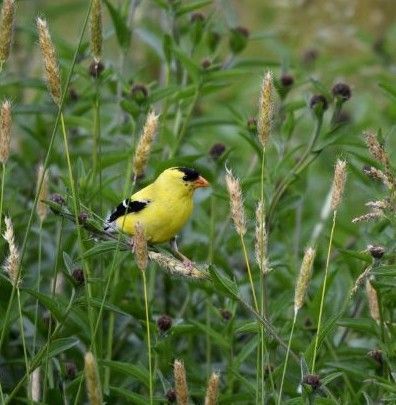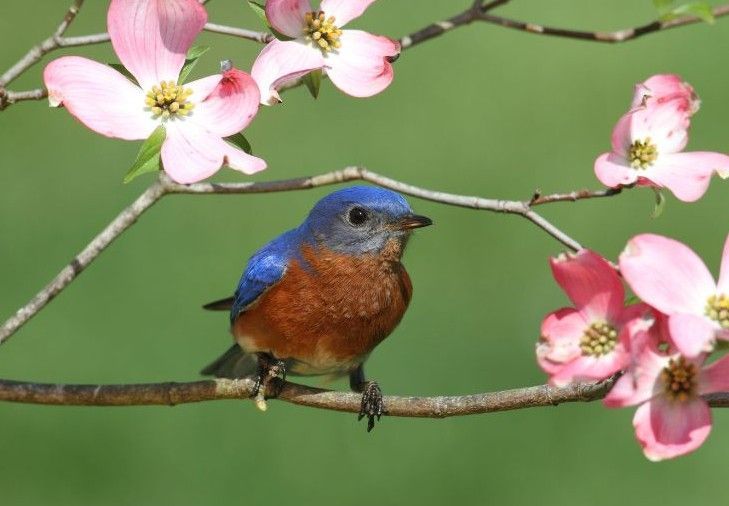Aster: Depending on the height of the variety you choose, asters are suitable for borders, rock gardens, or wildflower gardens. As well as being a valuable pollinator plant for bees and butterflies, its tasty seed heads are sought out by cardinals, chickadees, finches, nuthatches, and many other seed eaters.
Gardening for Pollinators: Attracting Birds and Pollinators to Your Garden
Gardening for pollinators and planting for birds often go hand in hand, as many pollinator-friendly plants also provide food and habitat for birds. Creating a bird-friendly environment is simply a matter of providing the creature comforts we all crave: food, protective cover, and a cozy spot for raising a family. Understanding a bird’s preferences will help you determine which plants to grow.
Different plants will support different needs, whether that bounty is in the form of seeds, fruits, nuts, or nectar. Plants also function as hosts for many caterpillars and insects, which are another important source of food for birds. A garden filled with a mixture of plants producing flowers, seeds, berries, and nuts will always attract the largest number and variety of birds.
As you develop your garden, consider grouping your plants in layers. You will be creating a multilevel habitat of food and shelter for a variety of birds, whether they feed on the ground, in trees and bushes, or in the air.
1. Upper Layers:
Include fruit-bearing shrubs, deciduous trees, and evergreens of all heights in your upper layers.
2. Middle Layers:
Fill the layers in between with perennials, annuals, ornamental grasses, and low-growing shrubs.
3. Ground Level:
At ground level, consider planting ground covers as well as petite perennials and annuals.
When it all comes together, your garden just may become a bird’s favorite place to be!

Here are some more tips on how to create a garden that attracts birds:
1. Select a Variety of Flowers:
Try to choose native plants that are well-suited to your local environment and supply essential nectar, pollen, and seeds that both pollinators and birds rely on. Research which native plants are best for your region. Plant a diverse array of flowers with assorted colors, shapes, and bloom times. This diversity will attract a wide range of pollinators and supply a consistent food source for birds.
Seed-eating birds, including goldfinches, chickadees, and towhees, will seek out seed heads from an assortment of flowering plants and ornamental grasses. Any daisy-like flowers such as sunflowers, asters, and black-eyed Susans, in addition to rudbeckias, zinnias, and echinaceas, would be good choices. Finches, sparrows, and nuthatches are a few of the birds that will flock to marigolds, cosmos, coreopsis, goldenrod, phlox, and a wide selection of salvias. Hummingbirds are happy with nectar from bee balm, geraniums, veronicas, delphiniums, and penstemons.

2. Include Bird-Friendly Trees and Shrubs:
They can provide shelter, nesting sites, and berries or seeds for birds. Planting trees and shrubs that attract birds is a wonderful way to support local wildlife and create a thriving ecosystem in your garden.
Remember, too, that birds are attracted to seasonal food. They will stay longer in your garden if it contains plants that flower or fruit at various times of the year.
- Hollies and roses supply winter fruit.
- Serviceberries and chokecherries offer late–spring berries.
- Blueberries and mulberries bear summer fruit.
- Honeysuckle and pyracantha round out the fruit season in the fall.
3. Offer a Variety of Food Sources
Understanding a bird’s preferences will help you determine which plants to grow. Different plants will support different needs, whether that bounty is in the form of seeds, fruits, nuts, or nectar. Plants also act as hosts for many caterpillars and insects, which are another important source of food for birds. A garden filled with a mixture of plants producing flowers, seeds, berries, and nuts will always attract the largest number and variety of birds.
4. Offer Nectar Plants
5. Provide Seed-Bearing Plants
Birds enjoy seeds from a variety of plants. Sunflowers, black-eyed Susans, and ornamental grasses produce seeds that many bird species love.
6. Install Bird Feeders
7. Add Water Features
8. Create Nesting Sites
Tip - Don’t cut down the flowers of plants like sunflowers, coneflowers, and black-eyed Susans in the fall, as their seed heads provide a valuable food source for birds in winter.
9. Create Shelter Using Plants
Plant shrubs and bushes that provide cover and shelter for birds. These plants can also serve as windbreaks and nesting sites.
Plants that provide shelter—a safe haven from predators, protective cover from harsh weather, or a cozy spot, whether to nest or just settle in for the night—appeal to just about any bird, regardless of food preference. But a plant that provides food and shelter says, “Come on in.”
Pine trees provide evergreen shelter that is enjoyed by many birds. They also produce nourishing pine seeds favored by chickadees.
Low-growing junipers not only hide birds from imminent danger, but also offer an insect buffet for ground–insect feeders such as wrens, towhees, and juncos, in addition to providing a bevy of berries for titmice and waxwings.
Some vines and shrubs (like Virginia creeper, clematis, service berry, and privet) are also multifunctional plants. Towhees, larks, and sparrows enjoy the seed heads of their spent flowers, while fruit-eating birds such as robins, thrushes, and tanagers gorge on their berries. These vines and shrubs also provide a safe haven.
10. Provide Perches
Birds often need perches to rest and observe their surroundings. You can incorporate bird-friendly perches or natural branches into your garden design.
By following these tips and creating a garden that offers a variety of food sources, nesting sites, and habitat, you can attract both pollinators and birds, creating a thriving ecosystem in your backyard.
Invite birds into your backyard and start enjoying a front-row view of nature’s winged wonders.
Conclusion:
By following these tips and creating a garden that offers a variety of food sources, nesting sites, and habitat, you can attract both pollinators and birds, creating a thriving ecosystem in your backyard.
Invite birds into your backyard and start enjoying a front-row view of nature’s winged wonders. Your garden will not only provide a haven for these beautiful creatures but also enrich your own life with the sights and sounds of a vibrant, living ecosystem. So, roll up your sleeves, get your hands in the soil, and let your garden become a sanctuary for pollinators and a haven for our feathered friends. In doing so, you'll not only contribute to local biodiversity but also find yourself rewarded with the endless beauty and wonder of nature right at your doorstep. Happy gardening!
Check out the latest:









